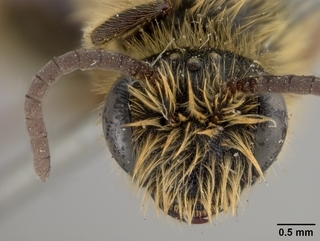
Smithsonian Institution, Entomology Department · 9
Andrena cyanophila, male, face |
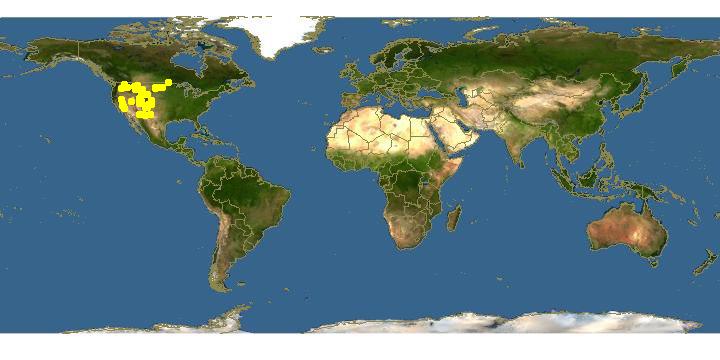
Click on map for details about points.
|
80x5 -
240x3 -
240x4 -
320x1 -
320x2 -
320x3 -
640x1 -
640x2
Set display option above.
Click on
images to enlarge. |
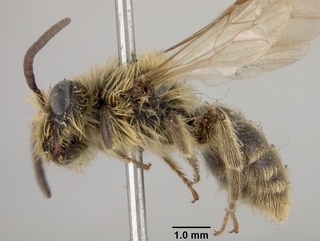
Smithsonian Institution, Entomology Department · 9
Andrena cyanophila, male, side |
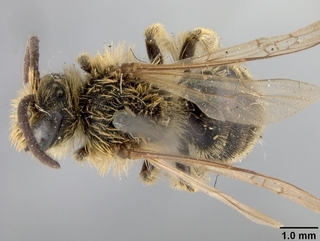
Smithsonian Institution, Entomology Department · 9
Andrena cyanophila, male, top |
|
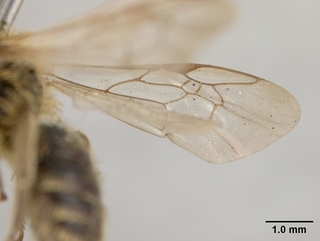
Smithsonian Institution, Entomology Department · 9
Andrena cyanophila, male, wing |
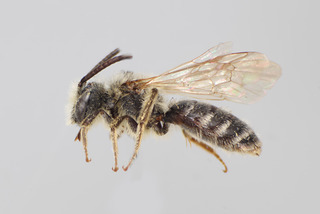
© Copyright Laurence Packer 2014
· 7
Andrena cyanophila MALE CFP |
|
Overview |
Reprinted with permission of the American Entomological Society from:
LaBerge, W. E. 1973. A revision of the bees of the genus Andrena of the Western Hemisphere. Part VI. Subgenus Trachandrena. Transactions of the American Entomological Society 99: 235-371.
Please report text errors to: leah at discoverlife dot org.
This is a small summer bee from the montane regions of the west. Andrena cyanophila is not closely related to any of the foregoing species but perhaps is closer to the amphibola group than any of the others. The female of cyanophila is distinctive in that the ventral surface of the genal area is punctate without rugulae and the facial fovea has the lower section broad (as in hippotes) but more or less parallel-sided rather than tapering as in other species with broad lower portions of the facial foveae. The lateral surface of the genal area of both sexes is moderately coarsely punctate without rugulae, the vertex short, and the propodeum outside of the dorsal enclosure relatively finely sculptured. The male of cyanophila has the first flagellar segment about as long as the second and segments 4-10 are short (if longer than broad, never as much as one and one-half times as long as broad), and the sixth sternum is broadly and rather shallowly emarginate apically.
FEMALE. MEASUREMENTS AND RATIOS. — N = 20; length, 8-11 mm; width, 2.5-3.0 mm; wing length, M = 3.37 ± 0.155 mm; FL/FW, M = 1.07 ± 0.005; FOVL/FOVW, M = 3.95 ± 0.045.
INTEGUMENTAL COLOR. — Black except as follows: mandible with apical half or more rufescent; flagellar segments 3- or 4-10 reddish-brown below; tegulae piceous with hyaline rim and often reddened or hyaline summits; wing membranes moderately infumate, yellow, veins dark brown to brownish-red; sterna and distitarsi dark rufescent; tibial spurs testaceous to red.
STRUCTURE. — Antennae as in sigmundi but flagellar segment 2 shorter than segment 3 and segments 4-9 quadrate or slightly broader than long. Eyes each four times as long as broad, inner margins parallel or converging slightly toward mandibles. Mandible, malar space and galea as in sigmundi. Maxillary palpus as in sigmundi but segmental ratio about as 1.0:1.0:0.7:0.6:0.4:0.4. Labial palpus as in sigmundi but ratio about as 1.0:0.5:0.3:0.4. Labral process as in sigmundi; labrum below process dull, with several weak cristae, without transverse sulcus. Clypeus and supraclypeal area as in sigmundi. Genal area in profile broader than eye (about as 13:11); lateral surface with moderately coarse punctures separated mostly by half a puncture width or less, surface shiny, only lightly shagreened, without rugulae; ventral surface similar but often slightly dulled. Vertex above lateral ocellus equals about one ocellar diameter, with coarse, round, crowded punctures (sparser over foveae) and fine irregular shagreening only slightly dulling surface. Face above antennal fossae coarsely and densely punctate, punctures occasionally arranged so that a few irregular interpunctural rugulae appear, but usually without rugulae; surface moderately shiny to shiny. Facial fovea narrow, separated above from lateral ocellus by three-fourths to one ocellar diameter, lower portion wider than half of upper portion and wider than greatest space between fovea and compound eye, but more or less parallel-sided with rounded lower end (not tapering as in mariae).
Pronotum normal, with crowded punctures above and sparse punctures laterally, shiny. Mesoscutum with coarse crowded punctures separated mostly by half a puncture width or more (sparser posteromedially); surface shiny, reticular shagreening extremely fine when present. Scutellum similar. Metanotum dulled by crowded small punctures and dense tessellation. Propodeum as in sigmundi but dorsal enclosure rugulae relatively fine. Mesepisternum as in sigmundi. Hind tibial spurs normal. Wing venation as in sigmundi.
Metasomal tergum 1 with apical area equal to half (usually slightly more) tergal length; apical area punctures moderately large, round, deep, separated irregularly by half to one and one-half puncture width (except in narrow impunctate apical rim); basal area punctures small to minute, sparse, separated by five to eight puncture widths or more; surface shiny, shagreening fine when present. Tergum 2 with apical area equal to less than twice basal area medially (about as 7:4); apical area punctures as in tergum 1 but separated mostly by half to one puncture width; basal area punctures crowded, separated mostly by half a puncture width or less; surface shiny. Terga 3 and 4 similar to tergum 2. Pygidial plate V-shaped with rounded apex and distinct raised internal triangular area. Sterna 2-5 as in sigmundi.
VESTITURE. — Generally pale ochraceous to yellow; vertex and thoracic dorsum often fox-red; basitibial hairs often brownish except inner surfaces yellow. Form and distribution of hairs as in sigmundi except dorsal thoracic hairs usually rather short and thick (but not appressed and scalelike) and terga 2-4 with white apical fasciae broadly interrupted medially (if present).
MALE. MEASUREMENTS AND RATIOS. — N = 20; length, 8-10 mm; width, 1.5-2.5 mm; wing length, M = 3.15 ± 1.05 mm; FL/FW, M = 1.10 ± 0.006; FS1/FS2, M = 0.97 ± 0.019.
INTEGUMENTAL COLOR. — Black with same exceptions as in female but narrow tergal rims often translucent or hyaline.
STRUCTURE. — Antennae short, in repose rarely reaching back beyond anterior margin of scutellum and usually shorter; scape length equals first two and one-half flagellar segments or more; flagellar segment 1 about equal to segment 2 in length, slightly shorter than segment 3; segments 3-10 as long as broad or slightly longer (never as long as one and one-half times width). Eyes each about three and one-half times as long as broad, inner margins distinctly converging toward mandibles. Malar space, mandible and galea as in female. Maxillary palpus as in female but segmental ratio about as 1.0:0.9:0.7:0.6:0.5:0.5. Labial palpus as in female but ratio about as 1.0:0.4:0.3:0.4. Labrum, clypeus and supraclypeal area as in sigmundi. Vertex as in female. Face above antennal fossae rugatulopunctate (without or with few irregular rugulae). Genal areas as in female but ventral surface usually with fine rugulae converging toward mandibles but not obscuring punctures.
Pronotum as in female. Thoracic sculpturing as in female but mesoscutal punctures smaller and propodeal dorsal enclosure with rugae less regularly longitudinal. Tibial spurs and wing venation as in female.
Metasomal terga 1-5 with apical areas equal to slightly but distinctly less than half length of each tergum; each tergum with extremely narrow impunctate rims; surfaces shiny, unshagreened. Tergum 1 with basal area punctures separated by half to one puncture width or more; apical area punctures slightly more crowded. Terga 2-5 with basal area punctures separated mostly by half a puncture width or less and apical area punctures slightly sparser (terga 4 and 5 with punctures usually slightly sparser than terga 2 and 3). Sterna 2-5 with impunctate apical areas and extreme bases, otherwise with distinct deep punctures separated mostly by one-half to one puncture width or more; surface shiny, reticular shagreening fine or absent. Sternum 6 with broad shallow apical emargination. Terminalia as in sigmundi; see figures 64-65.
VESTITURE. — Generally as in fuscicauda but less often red dorsally on thorax.
|
|
|
Names | |
|
|
| Supported by | |
Updated: 2024-04-19 03:41:44 gmt
|